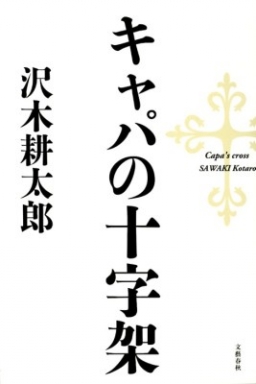2013/03/29 |
Capa's Cross made a big splash in Japan |
|---|
The Falling Soldier, a photograph taken by Robert Capa is one of the most iconic photographs of all time. It was thought to capture the moment of a Republican soldier's death during The Spanish Civil War but in reality the photograph had captured the moment a soldier had slipped during an exercise. Moreover, the photograph was not taken by Robert Capa.
Kotaro Sawaki, the author of Capa's Cross sheds light on the mystery of Capa's life in the year of 100th anniversary of his birth.
The Spanish Civil War broke out on the eve of the Second World War. It was a war waged between the Republicans, who were loyal to the established Spanish Republic, and the Nationalists, a rebel group led by General Francisco Franco. The Nationalists prevailed and Franco would rule Spain for the next 36 years. Many still remember the war as being a just war—a noble cause that was worth throwing themselves into.
After the war, two masterpieces remained as its legacy. One was Guernica, a painting by Pablo Picasso and the other was The Falling Soldier, a famous photograph taken by Robert Capa. The photograph was published in LIFE and went on to become one of the most iconic photographs of all time.
Kotaro Sawaki, the author of Capa's Cross, has collected many biographies on Robert Capa and his photography collections. In the process of collecting them, the author became skeptical about the authenticity of The Falling Soldier. He began asking when and how the photograph was taken, whether it was taken in the battlefield, and whether Robert Capa had taken it in the first place. To find answers, the author turned to countless annals of warfare and related photographs, examined landscapes, and even traveled to Spain, Paris, and New York before arriving at one firm conclusion, putting an end to his frantic research. The Falling Soldier was thought to capture the moment of a Republican soldier's death but in reality the photograph had captured the moment a soldier had slipped during an exercise. Moreover, the photograph was taken not by Robert Capa, but by Gerda Taro, Capa's professional partner and companion (she was hit by a tank and died soon after).
Readers will definitely enjoy the author's investigative accounts, comprised of intriguing considerations and elaborate verifications, but the last chapter alone may prove to be worth the price of the book. Titled "Road to Capa," this illuminating chapter tracks the trajectory of Robert Capa's journey from unknown Jewish-Hungarian photographer to a highly revered combat photojournalist after being catapulted into fame overnight with the release of The Falling Soldier. Guilt-ridden by the daring deception he had pulled off with the photograph, he went on to ventured into dangerous warzones and finally succeeded in taking the photograph titled 'Soldier Taking Cover at Omaha Beach on D-Day,' for which he became most famous.
Although Robert Capa had attained fame, fortune, and had even married the legendary actress, Ingrid Bergman, he had thrown himself back into the theaters of war time and time again to clear his name and redeem himself. It was a motivating force that had propelled him from an unknown fraud to a legendary authority, from zero to hero. The book sheds a poignant light on this transformative journey.
About the Author
Kotaro Sawaki is one of the most popular nonfiction writers in Japan. He made his name with "Shinya Tokkyu (Midnight Express)," a reportage of a yearlong overland trip through Asia and Europe, which he made when he was in his mid-twenties. The stories in the book ― whose title refers to a euphemism for "prison break" used by foreign inmates of an Istanbul prison ― depict in astonishing detail Sawaki's friendly interactions with the locals, his sometimes acrimonious bartering over bus fares, meals and accommodation ― and his heart-rending and movingly humorous descriptions of the poor and downtrodden he had encountered on his travels.
Sawaki's three-volume series, the first two of which came out in 1986 ― at the height of Japan's stupendous "bubble economy" ― inspired many of his young compatriots to go on the road in search of new horizons, with some following in his footsteps, journeying from Hong Kong to London.
Sawaki has received numerous awards for his nonfiction writings that span subjects as diverse as the biography of a professional baseball player who refused to accept that his career was over and a posthumous account of a marathon runner who, faced with enormous pressures to win at the Olympics, opted to commit suicide.

